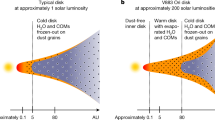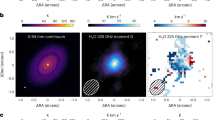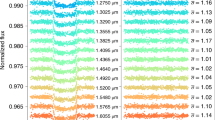Abstract
The detection1 of circumstellar water vapour around the ageing carbon star IRC +10216 challenged the current understanding of chemistry in old stars, because water was predicted2 to be almost absent in carbon-rich stars. Several explanations for the water were postulated, including the vaporization of icy bodies (comets or dwarf planets) in orbit around the star1, grain surface reactions3, and photochemistry in the outer circumstellar envelope4. With a single water line detected so far from this one carbon-rich evolved star, it is difficult to discriminate between the different mechanisms proposed. Here we report the detection of dozens of water vapour lines in the far-infrared and sub-millimetre spectrum of IRC +10216 using the Herschel satellite5. This includes some high-excitation lines with energies corresponding to ∼1,000 K, which can be explained only if water is present in the warm inner sooty region of the envelope. A plausible explanation for the warm water appears to be the penetration of ultraviolet photons deep into a clumpy circumstellar envelope. This mechanism also triggers the formation of other molecules, such as ammonia, whose observed abundances6 are much higher than hitherto predicted7.
This is a preview of subscription content, access via your institution
Access options
Subscribe to this journal
Receive 51 print issues and online access
$199.00 per year
only $3.90 per issue
Buy this article
- Purchase on Springer Link
- Instant access to full article PDF
Prices may be subject to local taxes which are calculated during checkout




Similar content being viewed by others
References
Melnick, G. J., Neufeld, D. A., Ford, K. E. S., Hollenbach, D. J. & Ashby, M. L. N. Discovery of water vapour around IRC+10216 as evidence for comets orbiting another star. Nature 412, 160–163 (2001)
Willacy, K. & Cherchneff, I. Silicon and sulphur chemistry in the inner wind of IRC+10216. Astron. Astrophys. 330, 676–684 (1998)
Willacy, K. A chemical route to the formation of water in the circumstellar envelopes around carbon-rich asymptotic giant branch stars: Fischer-Tropsch catalysis. Astrophys. J. 600, L87–L90 (2004)
Agúndez, M. & Cernicharo, J. Oxygen chemistry in the circumstellar envelope of the carbon-rich star IRC+10216. Astrophys. J. 650, 374–393 (2006)
Pilbratt, G. L. et al. Herschel Space Observatory — an ESA facility for far-infrared and submillimetre astronomy. Astron. Astrophys. 518, L1 (2010)
Hasegawa, T. I. et al. Observations of the circumstellar water 110 → 101 and ammonia 10 → 00 lines in IRC +10216 by the Odin satellite. Astrophys. J. 637, 791–797 (2006)
Cherchneff, I. & Barker, J. R. Polycyclic aromatic hydrocarbons and molecular equilibria in carbon-rich stars. Astrophys. J. 394, 703–716 (1992)
Iben, I., Jr & Renzini, A. Asymptotic giant branch evolution and beyond. Annu. Rev. Astron. Astrophys. 21, 271–342 (1983)
González-Alfonso, E., Neufeld, D. A. & Melnick, G. J. Water vapor emission from IRC+10216 and other carbon-rich stars: model predictions and prospects for multitransition observations. Astrophys. J. 669, 412–423 (2007)
Griffin, M. J., et al. The Herschel-SPIRE instrument and its in-flight performance.Astron. Astrophys. 518, L3 (2010)
Poglitsch, A. et al. The Photodetector Array Camera and Spectrometer (PACS) on the Herschel Space Observatory.Astron. Astrophys. 518,L2 (2010)
Decin, L. et al. Silicon in the dust formation zone of IRC+10216. Astron. Astrophys. 518, L143 (2010)
Talbi, D. & Bacchus-Montabonel, M. The formation of H2O from the radiative association of O and H2 . Chem. Phys. Lett. 485, 56–58 (2010)
Winters, J. M., Dominik, C. & Sedlmayr, E. Theoretical spectra of circumstellar dust shells around carbon-rich asymptotic giant branch stars. Astron. Astrophys. 288, 255–272 (1994)
Cherchneff, I. A chemical study of the inner winds of asymptotic giant branch stars. Astron. Astrophys. 456, 1001–1012 (2006)
Weigelt, G. et al. 76mas speckle-masking interferometry of IRC+10216 with the SAO 6m telescope: evidence for a clumpy shell structure. Astron. Astrophys. 333, L51–L54 (1998)
Leão, I. C., de Laverny, P., Mékarnia, D., de Medeiros, J. R. & Vandame, B. The circumstellar envelope of IRC+10216 from milli-arcsecond to arcmin scales. Astron. Astrophys. 455, 187–194 (2006)
Fong, D., Meixner, M. & Shah, R. Y. Discovery of multiple molecular shells in the outer envelope of IRC+10216. Astrophys. J. 582, L39–L42 (2003)
Dinh-V-Trung & Lim, J. Molecular shells in IRC+10216: evidence for nonisotropic and episodic mass-loss enhancement. Astrophys. J. 678, 303–308 (2008)
Guélin, M., Lucas, R. & Cernicharo, J. MgNC and the carbon-chain radicals in IRC+10216. Astron. Astrophys. 280, L19–L22 (1993)
Querci, F., Querci, M. & Tsuji, T. Model atmospheres for C type stars. Astron. Astrophys. 31, 265–282 (1974)
Gustafsson, B. et al. A grid of MARCS model atmospheres for late-type stars. I. Methods and general properties. Astron. Astrophys. 486, 951–970 (2008)
Menten, K. M. & Alcolea, J. Detection of ammonia emission toward oxygen-rich evolved stars. Astrophys. J. 448, 416–425 (1995)
Tsuji, T. Molecular abundance in stellar atmospheres. Ann. Tokyo Astron. Obs. 9, 1–110 (1964)
Agúndez, M., Cernicharo, J. & Guélin, M. Photochemistry in the inner layers of clumpy circumstellar envelopes: formations of water in C-rich objects and of C-bearing molecules in O-rich objects. Astrophys. J. (submitted)
Bujarrabal, V., Fuente, A. & Omont, A. Molecular observations of O- and C-rich circumstellar envelopes. Astron. Astrophys. 285, 247–271 (1994)
Decin, L. et al. Circumstellar molecular composition of the oxygen-rich AGB star IK Tau: II. In-depth non-LTE chemical abundance analysis. Astron. Astrophys. 516, A69 (2010)
Duari, D., Cherchneff, I. & Willacy, K. Carbon molecules in the inner wind of the oxygen-rich Mira IK Tauri. Astron. Astrophys. 341, L47–L50 (1999)
McCabe, E. M., Smith, R. C. & Clegg, R. E. S. Molecular abundances in IRC + 10216. Nature 281, 263–266 (1979)
Glassgold, A. E. Circumstellar photochemistry. Annu. Rev. Astron. Astrophys. 34, 241–277 (1996)
Acknowledgements
Herschel is an ESA space observatory with science instruments provided by European-led Principal Investigator (PI) consortia and with important participation from NASA. PACS has been developed by a consortium of institutes led by MPE (Germany) and including UVIE (Austria); KUL, CSL, IMEC (Belgium); CEA, OAMP (France); MPIA (Germany); IFSI, OAP/AOT, OAA/CAISMI, LENS, SISSA (Italy); and IAC (Spain). This development has been supported by the funding agencies BMVIT (Austria), ESA-PRODEX (Belgium), CEA/CNES (France), DLR (Germany), ASI (Italy) and CICT/MCT (Spain). SPIRE has been developed by a consortium of institutes led by Cardiff University (UK) and including the University of Lethbridge (Canada); NAOC (China); CEA, LAM (France); IFSI, the University of Padua (Italy); IAC (Spain); Stockholm Observatory (Sweden); Imperial College London, RAL, UCL-MSSL, UKATC, University of Sussex (UK); and Caltech, JPL, NHSC, the University of Colorado (USA). This development has been supported by national funding agencies: CSA (Canada); NAOC (China); CEA, CNES, CNRS (France); ASI (Italy); MCINN (Spain); SNSB (Sweden); STFC (UK); and NASA (USA). IRAM is supported by INSU/CNRS (France), MPG (Germany) and IGN (Spain).
Author information
Authors and Affiliations
Contributions
L.D. identified the molecular lines, analysed and interpreted the PACS and SPIRE data and performed the non-local-thermodynamic equilibrium (non-LTE) radiative transfer computations; M.A. and J.C. were responsible for the chemical modelling; M.J.B. was mainly responsible for the Herschel MESS Key program observations performed with the SPIRE instrument; M.A.T.G. is PI of the Herschel MESS Key program, F.D. checked the non-LTE radiative transfer calculations, R.L. modelled the spectral energy distribution; E.D.B. identified molecular lines; P.R. and B.V. were responsible for the calibration of the PACS observations; R.W. and E.T.P. were responsible for the calibration of the SPIRE observations; the rest of the authors belong to the Herschel MESS consortium, the framework in which the Herschel PACS and SPIRE spectroscopic observations were performed.
Corresponding author
Ethics declarations
Competing interests
The authors declare no competing financial interests.
Supplementary information
Supplementary Information
This file contains Supplementary Notes 1-2, Supplementary Figures 1-6 with legends, Supplementary Table 1 and additional references. (PDF 371 kb)
Rights and permissions
About this article
Cite this article
Decin, L., Agúndez, M., Barlow, M. et al. Warm water vapour in the sooty outflow from a luminous carbon star. Nature 467, 64–67 (2010). https://doi.org/10.1038/nature09344
Received:
Accepted:
Issue Date:
DOI: https://doi.org/10.1038/nature09344
This article is cited by
-
From bridges to cycles in spectroscopic networks
Scientific Reports (2020)
-
The 21 μm and 30 μm emission features in carbon-rich objects
Astrophysics and Space Science (2020)
-
Graphene etching on SiC grains as a path to interstellar polycyclic aromatic hydrocarbons formation
Nature Communications (2014)
-
Unexpected warm water
Nature (2010)
Comments
By submitting a comment you agree to abide by our Terms and Community Guidelines. If you find something abusive or that does not comply with our terms or guidelines please flag it as inappropriate.



